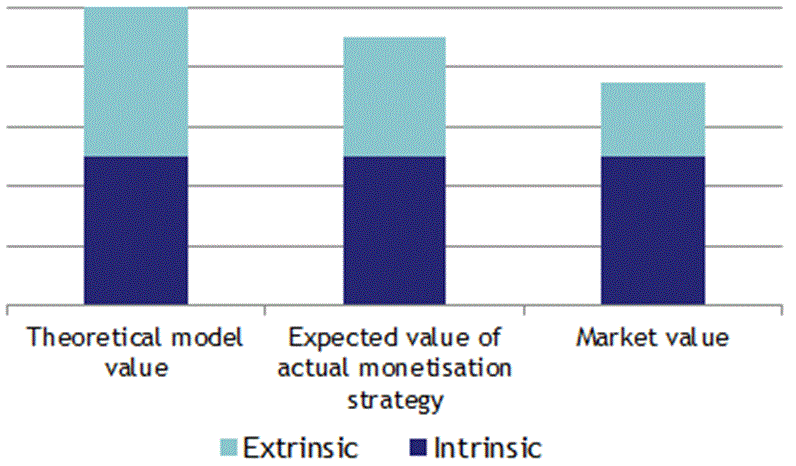There is a real financial cost associated with the risk around an asset’s earnings. In the case of asset investments, it is conventional wisdom to apply a premium to reflect the cost of risk as part of the investment hurdle rate used to discount asset cashflows. But when it comes to valuing energy contracts, a standard approach for risk discounting is less clearly defined.
There is currently an industry wide debate in Europe about flexible energy contracts being ‘underpriced’ relative to modelled value. For example, gas storage capacity, swing contracts or CCGT tolling capacity are regularly cited as being ‘cheap’ relative to expected returns.
This is in part driven by market expectations which reflect an extrapolation of the current depressed levels of market volatility. But the ‘market value’ of a contract also sits at a discount to ‘expected value’ because of the costs of monetising contract value. This factor is often overlooked, as the terms ‘expected value’ and ‘market value’ are used interchangeably when referring to energy contracts. In this article we focus on the drivers of the costs of contract monetisation.
Expected vs Market value
Valuation of flexible energy contracts typically involves modelling an optimised expected value of the contract. Often the primary modelling focus is on capturing the interaction of complex market price dynamics with contract flexibility. The importance of this analysis is clear.
But to understand the market value of a contract, it is just as important to understand the costs associated with optimising and hedging the contract, e.g. risk capital and transactions costs. These costs are real and provide a bridge between modelling theory and the reality of cash through the door as the contract is monetised on a trading desk.
There are two common issues which can undermine the market valuation of energy contracts:
- Modelled expected value does not account for the actual hedging and optimisation strategy employed to monetise asset value (e.g. a spot optimisation gas storage model is used to model the value of storage capacity that is monetised via a rolling intrinsic hedging strategy)
- Modelled expected value is not adjusted to reflect the costs associated with monetising contract value.
These factors are two key drivers behind the commonly observed relationship that model valuations are higher than market valuations for flexible contracts. The difference between theoretical, expected and market value is simply illustrated in Chart 1.
The costs of monetising contract value
In the table below we set out the key costs that can drive a wedge between the expected and market value of an energy contract.
Chart 2 provides a simple illustration of the most important driver of contract monetisation costs, market risk. The chart shows the modelled distribution of returns for two contracts with the same expected value. The greater risk associated with Contract 2 requires more risk capital which should be reflected in a lower market price.
The table above focuses on the variable costs that drive contracting decisions. In addition there are also direct (e.g. employment) and indirect (e.g. corporate overhead allocation) costs associated with supporting a trading function. Although these costs need to be covered by a trading business (and should be included for trader performance incentivisation), they are typically considered to be sunk costs that do not drive marginal contracting decisions.
Capturing costs of monetisation in contract valuation
It can be tempting to try to capture the hedging and optimisation costs (hedging costs and liquidity risk) directly into the valuation model. However, in many cases these costs do not fit naturally into the parameters of model, often ending up as ‘fudges’.
For example, when modelling gas storage capacity value with a spot optimisation model, a crude way of reflecting hedging costs is to increase the spot b/o spread assumption. But this sort of approach only undermines the transparency and robustness of valuation analysis. It is much cleaner to keep the model inputs ‘true’ and to make adjustments to modelled value to reflect monetisation costs. The fact that monetisation costs can often be more abstract and subjective also adds weight to applying a more simple and transparent methodology.
Applying the costs of contract monetisation
The most obvious application of the calculated cost of monetising a contract is to determine the discount that should be applied to expected value in order to estimate market value. This is clearly useful for benchmarking existing contract value. But monetisation costs are also an important component in calculating the value of a structured transaction before showing a price to a counterparty.
The costs of contract monetisation are also a key input for effective benchmarking and incentivisation of trading performance. These costs should be netted against headline margins generated within a trading book to calculate a fair reflection of trader ‘value added’.
In a capital constrained environment, the costs of monetising energy contract value are well understood in banks and commodity trading firms. It is common practice for these companies to explicitly charge out the balance sheet capacity required to support market and credit risk, the main drivers of contract monetisation costs. But for many European utilities, contract monetisation costs are still only given summary consideration.


